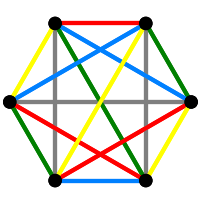Section8.1Forbidden Words
Let \(\al\) denote a binary string, and let \(L\) denote the set of binary of binary strings that do not contain \(\al\) as a substring. How many strings are there in \(L\) with length \(n\)?
Let \(M\) denote the binary strings that contain exactly one copy of \(\al\), as a suffix. If \(\eps\) denotes the empty string, then
Lemma8.1.1
Note that \(\al\backslash\al\) is a finite language, i.e., a finite set of strings.
If \(N\) is a set of binary strings, let \(N(t)\) denote its generating series. This is what we get when we substitute \(t\) for \(0\) and \(1\), a string of length \(\ell\) maps to \(t^\ell\) and the language maps to its generating series. Now \eqref{eq-eL01} yields
Lemma8.1.2
Let's use this to compute some numbers. We first set up the ring of formal power series over the rationals.
If \(\al=111\), then \(D(t)=1+t+t^2\) and \(L(t)\) is
As an exercise, write a program which takes a binary string \(\al\) and computes the generating series for \(\al\backslash\al\). (The string arrives as a Python string, there is no reason why your procedure should not work for strings over an arbitrary alphabet.)
The square root of the series \(L(2t)\) has non-negative integer coefficients.
Does this hold for other forbidden substrings?
For a second variant, suppose \(\cF=\{\seq\al1d\}\) is a set of binary strings. Let \(L\) be the set of strings that contain no element of \(\cF\) and let \(M_i\) denote the set of strings that contain one copy of \(\al_i\), as a suffix, but do not contain any other copies of strings in \(\cF\). If \(|\cF|=2\), we have equations
